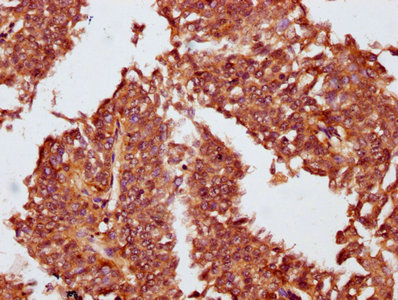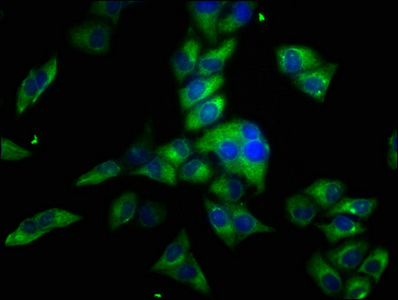OBSCN Antibody
产品详情
-
产品名称:Rabbit anti-Homo sapiens (Human) OBSCN Polyclonal antibody
-
Uniprot No.:Q5VST9
-
基因名:OBSCN
-
别名:BC046431 antibody; Gm878 antibody; KIAA1556 antibody; KIAA1639 antibody; OBSCN antibody; OBSCN_HUMAN antibody; Obscurin antibody; Obscurin-MLCK antibody; Obscurin-myosin light chain kinase antibody; Obscurin-RhoGEF antibody; OTTMUSG00000005786 antibody; UNC89 antibody
-
宿主:Rabbit
-
反应种属:Human
-
免疫原:Recombinant Human Obscurin protein (1621-1712AA)
-
免疫原种属:Homo sapiens (Human)
-
标记方式:Non-conjugated
本页面中的产品,OBSCN Antibody (CSB-PA729422LA01HU),的标记方式是Non-conjugated。对于OBSCN Antibody,我们还提供其他标记。见下表:
-
克隆类型:Polyclonal
-
抗体亚型:IgG
-
纯化方式:>95%, Protein G purified
-
浓度:It differs from different batches. Please contact us to confirm it.
-
保存缓冲液:Preservative: 0.03% Proclin 300
Constituents: 50% Glycerol, 0.01M PBS, pH 7.4 -
产品提供形式:Liquid
-
应用范围:ELISA, IHC, IF
-
推荐稀释比:
Application Recommended Dilution IHC 1:20-1:200 IF 1:20-1:200 -
Protocols:
-
储存条件:Upon receipt, store at -20°C or -80°C. Avoid repeated freeze.
-
货期:Basically, we can dispatch the products out in 1-3 working days after receiving your orders. Delivery time maybe differs from different purchasing way or location, please kindly consult your local distributors for specific delivery time.
相关产品
靶点详情
-
功能:Structural component of striated muscles which plays a role in myofibrillogenesis. Probably involved in the assembly of myosin into sarcomeric A bands in striated muscle. Has serine/threonine protein kinase activity and phosphorylates N-cadherin CDH2 and sodium/potassium-transporting ATPase subunit ATP1B1. Binds (via the PH domain) strongly to phosphatidylinositol 3,4-bisphosphate (PtdIns(3,4)P2) and phosphatidylinositol 4,5-bisphosphate (PtdIns(4,5)P2), and to a lesser extent to phosphatidylinositol 3-phosphate (PtdIns(3)P), phosphatidylinositol 4-phosphate (PtdIns(4)P), phosphat...显示更多
-
基因功能参考文献:
- association of frameshift and splicing variants, all clustering to the C terminus of the same isoform group, with occurrence of rare left ventricular noncompaction phenotype PMID: 27855815
- demonstrate that loss of giant obscurins from breast epithelial cells is associated with significantly increased phosphorylation and subsequent activation of the PI3K signaling cascade PMID: 27323778
- suggest that the combination of the OBSCN p.Arg4444Trp variant and of the FLNC c.5161delG mutation, can cooperatively affect myofibril stability and increase the penetrance of muscular dystrophy in the French family PMID: 29073160
- Crystal structure of the obscurin(-like-1):myomesin complex reveals a trans-complementation mechanism whereby an incomplete immunoglobulin-like domain assimilates an isoform-specific myomesin interdomain sequence. PMID: 27989621
- OBSCN mutations may result in the development of a familial dilated cardiomyopathy (DCM) phenotype via haploinsufficiency. These mutations should be considered as a significant causal factor of DCM, alone or in concert with other mutations. PMID: 26406308
- Gene-based association analyses shows nominal significant association with multifocal fibromuscular dysplasia for obscurin. PMID: 26147384
- Findings indicate that loss of giant obscurins from breast epithelium results in disruption of the cell-cell contacts and acquisition of a mesenchymal phenotype that leads to enhanced tumorigenesis, migration and invasiveness in vitro and in vivo. PMID: 25381817
- Loss of the obscurin-RhoGEF downregulates RhoA signaling and increases microtentacle formation and attachment of breast epithelial cells. PMID: 25261370
- this study presents here the X-ray structure of the human titin:obscurin M10:O1 complex extending our previous work on the M10:OL1 interaction. PMID: 25490259
- Obscurin and KCTD6 regulate cullin-dependent small ankyrin-1 (sAnk1.5) protein turnover PMID: 22573887
- Nontumorigenic MCF10A breast epithelial cells stably transduced with shRNAs targeting giant obscurins exhibited increased viability ( approximately 30%) and reduced apoptosis ( approximately 20%) following exposure to the DNA-damaging agent etoposide. PMID: 22441987
- OBSCN polymorphisms, in particular, highly conserved nonsynonymous Leu2116Phe variant, might contribute to aspirin hypersensitivity in asthmatics PMID: 22251166
- Results describe the molecular basis for the head-to-tail interaction of the carboxyl terminus of titin and the amino-terminus of obscurin-like-1 by X-ray crystallography. PMID: 20489725
- Results suggest that obscurin binds small ankyrin 1, and document a specific and direct interaction between proteins of the sarcomere and the sarcoplasmic reticulum. PMID: 12631729
- The complete gene giant muscle protein obscurin was analysed. The fusion of the conventional obscurin A, containing only the GEF domain, and obscurin B, fusing into the 3' kinase exons, was experimentally confirmed and analysed. PMID: 16625316
- OBSCN and C9orf65 comprise a highly accurate two-gene classifier for differentiating gastrointestinal stromal tumors and leiomyosarcomas. PMID: 17360660
- Studies suggest that the obscurin abnormality may be involved in the pathogenesis of hypertrophic cardiomyopathy. PMID: 17716621
- Structural and mutational studies of the binding region on small Ank1 for obscurin suggest that it consists of two ankyrin repeats with very similar structures. PMID: 17720975
- Obscurin was never lacking in myofibrillar alterations, but was either preserved at the M-band level or diffusely spread over the sarcomeres. PMID: 18350308
- These findings reveal a novel signaling pathway in human skeletal muscle that involves obscurin and the Rho GTPase TC10 and implicate this pathway in new sarcomere formation. PMID: 19258391
收起更多
-
相关疾病:A chromosomal aberration involving OBSCN has been found in Wilms tumor. Translocation t(1;7)(q42;p15) with PTHB1.
-
亚细胞定位:[Isoform 3]: Cytoplasm, myofibril, sarcomere, M line. Cytoplasm, myofibril, sarcomere, Z line.
-
蛋白家族:Protein kinase superfamily, CAMK Ser/Thr protein kinase family
-
数据库链接:
HGNC: 15719
OMIM: 608616
KEGG: hsa:84033
UniGene: Hs.650039
























